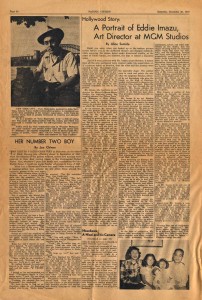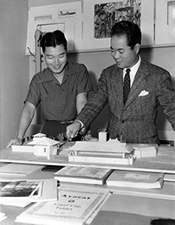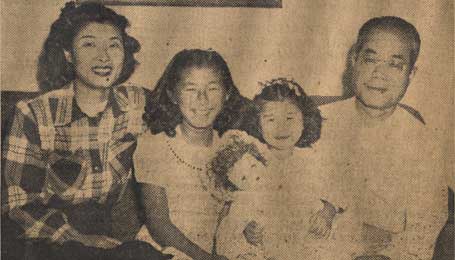From: Pacific Citizen, a Japanese-American Newspaper, page 24.
Date: Saturday, December 20, 1947.
By Alice Sumida.
Right you were, when you looked up at the motion picture screen before you in the darkened theatre and stopped suddenly, while scanning the names listed under directorial credits, at the name of Eddie Imazu, art director, for that is indeed a Japanese name.
And if it was a picture with Mr. Imazu as art director, it meant that all the sets portrayed were created under his supervision or, if a picture taken on location, that the sites and the scenery were selected by him. The budget from which he works usually comprises twelve per cent of the entire production cost set aside for a picture, which often means a budget of about $250,000. His job can entail anything from seeing to it that oil wells are placed on the landscape or that roads be constructed expressly for use in the picture.
Mr. Imazu, who has been an art director for Metro-Goldwyn-Mayer Studios for eighteen years, has handled pictures like “Boom Town,” and “Romance of Rosy Ridge,” with the first strongly-dramatic picture made by Mickey Rooney, soon to be released, being the latest on which Mr. Imazu has worked.
As art director, Mr. Imazu handles each picture, first by getting the script in his hands and then lining up the sets needed. A “roughing out” of sets is done, followed by putting them in drafting. After the models are drawn up, the director’s approval is obtained. If the budget worked out is suitable, the sets are built, assembled on the stage, and set up. They are then painted, dressed, and made ready to shoot. Mr. Imazu follows the procedure through from beginning to end, supervising at all points where the layout of the picture is concerned and seeing to it that adequate sets are made from a budget not exceeding 15% of the picture.
The art director takes about a month or two to prepare everything – the break down to sets, estimates, layouts, and the drawing and sketching of models. Shooting begins when everything is as the producer, director, and cameramen want it. By the starting date, the sets are built and dressed. In technicolor pictures, the color scheme on the sets is important, as they must not clash with the color of the costumes. Wardrobe designers are consulted beforehand in each case where technicolor shots will be involved.
A few sets are up at the time shooting of the pictures commences, and according to the schedule set, the sets to follow are put up on different stages in order to be a little ahead of the shooting. Mr. Imazu has two sketch artists who work on continuity and set sketches, along with perhaps, half a dozen draftsmen who are concerned with drawing out the layout and the details of the sets. Before the war, since from twelve to fourteen pictures were being made at the same time, eighty draftsmen used to be employed, but now, due to the fewer number of pictures made at one time, the draftsmen number twenty-five. From the workroom of the draftsmen, the plans go to the mill, where the units are made. Then each wall is fitted to each other when temporarily set up on the assembly stage. The painter goes to work and paints the sets after the carpenter finishes, followed by set decorators who give the lineup on the kind of furniture needed and proceed to decorate the furniture thus obtained. When the drapery man has dressed the set properly, Mr. Imazu obtains the director’s agreement as to the suitability of all that has been done. This procedure is followed with ensuing sets.
Mr. Imazu is an art director now, because when he first started out in the movie industry, he made the decision to go into a line not previously pursued by anyone of Japanese ancestry. He was in his second year at the University of California at Berkeley at the time he was invited, during a summer vacation spent here, to a party given by Sessue Hayakawa, the actor. A supervising art director at the old Metro studio who was at the same party, asked Mr. Imazu whether he would like to take on a job with him. Mr. Imazu had a choice of becoming a cameraman or of going into the art field. He chose the latter and was with the Metro Studio from 1920 until its merger in 1924 with Goldwyn and Mayer. He worked in the capacity of draftsman until 1929, at which time he was made art director and began handling pictures. Mr. Imazu had architectural training at high school and for two years at the University of California at Berkeley. Incidentally, he was the first Japanese to graduate Hollywood High School.
Since becoming art director, Mr. Imazu has done little actual drawing, having to do only rough sketches for the sketch artist occasionally to give the latter an idea of what he has in mind as regards to the work to be done. Mr. Imazu considers his work highly interesting, for the architecture dealt with in pictures is in different settings, and he is able to deal with the architecture of France, England, Italian, Spanish, and others. When Mr. Imazu wishes to have certain information concerning these differing types of architecture, he gets in contact with the studio research department, which then gathers the data desired and sends it back to him.
The only oriental picture Mr. Imazu has worked on is “Mr. Woo,” a picture made a number of years ago. When other oriental pictures were made, Mr. Imazu was busy on still other pictures. When Mr. Imazu goes on his trips to pick out locations for pictures which require them, he is, at times gone from the home studio for weeks at a time. After he selects the place most suitable, the location man goes, then, to rent it. No picture made at the studio costs less to produce than a million and a half.
At the time of evacuation, Mr. Imazu, who, according to authoritative sources, gets along wonderfully with producers, directors, cameramen, actors, and other individuals in the studio, had the chance of living inside the immense studio walls, but since his wife, Aiko, and his daughters, Darleen and Joyce, now ages 4 and 11 respectively, were forced to go to Santa Anita Assembly Center and, later, to the Jerome and Rohwer Relocation Centers, he understandably, went along with the rest of his family, forsaking his life of security with the studio. The day after the arrival back in Culver City of Mr. Imazu and his family, Cedric Gibbons, supervising art director at the studio, sent a wire requesting Mr. Imazu to go back to work with the studio again. And Mr. Mayer, who is generally considered by Hollywood greats as a difficult man to get to see, personally greeted Mr. Imazu back to the studio.
Mrs. Imazu, a native of Los Angeles, is, herself, an accomplished artist. Whereas she prefers “rough sketches executed mostly in charcoal,” her husband goes in more for complicated and meticulous details in his art work. Both Mr. and Mrs. Imazu are excellent golfers, and whenever they have time, they are out on the green. George Inagaki, first vice-president of the national JACL who lives a block or two away from the Imazus, is also a golfing enthusiast and joins the Imazus in a game whenever possible.
Mr. Imazu encourages Niseis to enter art work with motion picture companies. “I’m an Issei,” says Japan-born Mr. Imazu, “and I’m in. Imagine what a Nisei might be able to do.” He pointed out that ability is the important thing, and that race does not matter. However, the initial step may be difficult because of unionization. The step to take here would be to apply for a permit card to get into this line of work, which will be good for six months. After one’s name is submitted to the union and if there is no reason to refuse it, admittance is granted. A senior set designer’s status is achieved after three years work. Personality counts of course, but each set designer is watched closely to see whether or not he has the ability to handle a picture. If one is considered worthy for the position, one is first made an assistant art director, then, later, a full-fledged art director. Mr. Imazu believes that Nisei would do well to get into a studio, even if it be a small one, such as RKO or Warner Brothers.
As Mr. Imazu is in and out of the stages while the pictures are shot, he sees stars on the set every day and says that they are just like any other human being. They are nice to work with, and are far from being as tempermental as pictured in movie magazines.
Japan-born Mr. Imazu, a man of humility and great talent, is interested in Issei naturalization, and is hoping that it will be possible soon for those in America who were born in Japan to obtain their citizenship here. He has no intentions of going back to Japan, and is as American as the Mickey Rooney pictures he helps to create.



